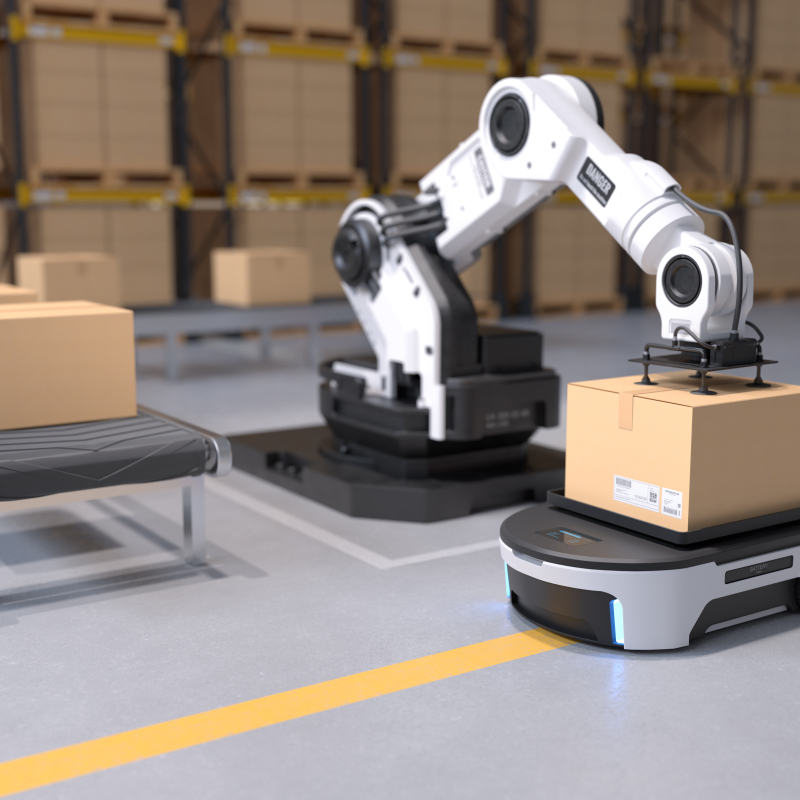What is the difference between an automated mobile robot and a robot?
Autonomous mobile robots (AMRs) have been developed to transform traditional warehouse environments into smarter, safer operations. They take on difficult, time-consuming and often dangerous tasks so warehouse operatives can benefit from improved productivity, increased efficiency, enhanced safety, limited errors, and better use of human labour, all of which offer optimal routes to success in your respective industry sector.
Loading and unloading trailers, stacking and retrieving items (even in narrow aisles and high bays), picking and sorting, inventory counting and management, and cleaning and disinfecting are just some of the tasks warehouse environments choose to automate with AMRs and automated guided vehicles (AGVs). But what are these wondrous pieces of equipment capable of revolutionising your warehouse management system and wider supply chain?
What defines a robot?
A robot is defined as any autonomous machine or automatic device that’s capable of performing a function to the same or similar standard as an intelligent creature. These capabilities include anything from sensing its surroundings and avoiding obstacles to making decisions and performing required actions.
What is an autonomous mobile robot?
A bespoke autonomous mobile robot or AMR differs from the more traditionally used automated guided vehicle (AGV) as well as the more generalised definition of a robot.
An AMR operates without direct driver input or pre-configured scripts to control its steering, acceleration and braking. Its machine learning capabilities mean an AMR can actively learn from every new situation it encounters to become more efficient and accurate over time.
AMRs are so efficient that they now regularly replace human labour, particularly for the completion of mundane, tedious and repetitive tasks, or potentially dangerous or harmful jobs.
What are the differences between the two?
Whilst both AMRs and AGVs are unmanned, each utilises different technology to unlock a selection of advantages within industrial environments.
Autonomous mobile robots are highly specialised pieces of equipment that go beyond the capabilities of many robots. When compared to guided vehicles (which use pre-determined or defined routes), AMRs rely on laser-based perception and navigation algorithms to dynamically move through facilities infrastructure-free.
Unlike wire- and rail-guided AGVs, autonomous mobile robots are not dependent on physical floor markings. More advanced sensor systems can plan their paths and make decisions to ensure optimal routes that evade obstructions (obstacles that stop an automated guided vehicle in its tracks), and achieve maximum productivity and time savings.
What are the advantages of AMRs?
Autonomous mobile robots are extremely advantageous when put to work in modern day warehouse environments. Models use trackless navigation to ensure a seamless, safer setting for all workers. They also have the capacity to identify and avoid obstacles, finding the most optimal routes to fulfil duties to the highest standards.
As your business expands and demand from your customer base increases, you can rest safe in the knowledge that AMRs can be quickly and simply remapped and redeployed to accommodate greater output, new locations or different objectives without the need for the installation of new tracks, infrastructure or units. Both autonomous mobile robots and automated guided vehicles can be charged via docking stations for hassle-free, easy maintenance.
Deciding whether an autonomous mobile robot or guided vehicle is right for you depends on your warehouse’s requirements and supply chain needs. With the capacity to fulfil a broad range of tasks more efficiently, effectively, affordably and safely, you’re certain to find the right warehouse robotics for you here at Guidance Automation.




